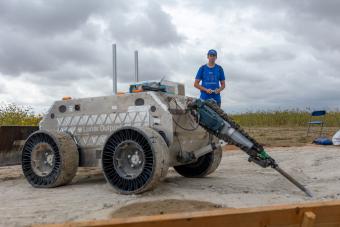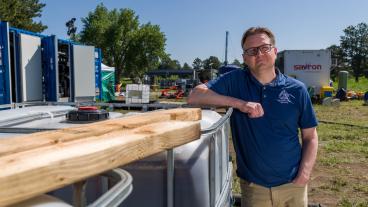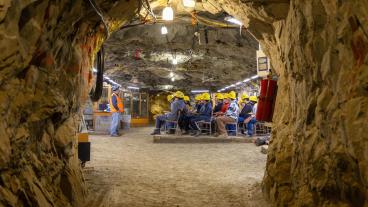Mines, Lunar Outpost test lunar excavation rover in 15-day durability demonstration
Outpost Digger System to operate for 15 consecutive days at Colorado Air and Space Port starting Sept. 9

Mechanical Engineering graduate student Brendan Kearney operates the impact hammer on the Outpost Digging System on the third day of durability testing at the Colorado Air and Space Port. Mines students from all disciplines had the opportunity to volunteer to help during the 15-day durability demonstration as part of the NASA Break the Ice Challenge. (Photo by Agata Bogucka/Colorado School of Mines)
Colorado School of Mines and Lunar Outpost will put their lunar excavation rover to the test this month – here on Earth – to demonstrate the durability of the technology.
The 15-day test, part of NASA’s Break the Ice Lunar Challenge, began Sept. 9 at the Colorado Air and Space Port near Watkins. Under the terms of the challenge, the two-rover Outpost Digger System must excavate, transport and dump at least 12 metric tons of concrete-hard lunar regolith simulant over a continuous 15-day test period. The demonstration will be live streamed to NASA officials.
“We’re excited to test the Outpost Digger System. Excavating and transporting that much concrete will be a challenge,” said George Sowers, professor of Space Resources at Mines. “However, data on the long-term durability of excavation systems under stressing conditions will be invaluable in designing mining systems for the Moon.”
The Outpost Digger System (ODS) brings together the unique strengths of Mines and Lunar Outpost. Mines researchers focused on optimizing the excavation implements and Lunar Outpost designed and built the rover platform.
The Outpost Digger System builds upon Lunar Outpost’s Hound Robotic Platform. The platform is more than 10 times the size of its smaller sibling, the Mobile Autonomous Prospecting Platform (MAPP), which is scheduled to fly to the Moon in 2023 and 2024 and will be the first commercial rover platform to explore the Moon. Key technologies developed for MAPP are being used in the Outpost Digger System, creating a clear path to space flight for the larger excavation system.
Lunar Outpost designed the ODS rover to be able to traverse long distances and provide power to a high energy impact hammer. This required an innovative ultra-high-capacity battery system and rapid charger. Each rover will excavate five hours a day and drive 38 kilometers over the course of the competition.
The test site at the Colorado Air and Space Port will utilize low-strength concrete to simulate the properties of lunar ice. ODS will use an impact hammer to break apart the concrete into manageable portions. A large bucket scoop will then harvest the “ice” and drive it to a depot to be weighed and stored. ODS has a specialized drive train designed for carrying the loads of the impact hammer and massive bucket scoop. The rovers are also equipped with robust airless tires, similar to a design that could be used in space.
“The Outpost Digger System represents a new technology that is not only pushing the boundaries of what can be possible on the lunar surface but will also serve as a useful robotic platform for mining and construction on Earth,” said Van Wagner, project manager for Lunar Outpost. “The NASA Break the Ice Challenge has been a catalyst for proving this technology in an exceptionally intense and rigorous way.”
Aimed at the development of the water resources on the Moon, the NASA Break the Ice Lunar Challenge was designed to incentivize innovation around the excavation and delivery of icy regolith in extreme lunar conditions. Key to the challenge is maximizing the resources delivered while minimizing the energy used and the mass of equipment delivered to the Moon.
The Ice Diggers, the nickname for the Mines-Lunar Outpost group, was one of 15 teams selected by NASA in December 2022 to move on to the semifinal round of the challenge. The results of the 15-day demonstration tests will determine who moves on to the final round, in which teams will put their protypes to the test in a head-to-head onsite competition for a shot at $1.5 million in prizes.
MEDIA CONTACTS
Emilie Rusch, Director of Communications, Colorado School of Mines, erusch@mines.edu
Kealy Kenrick, Marketing Manager, Lunar Outpost, kealy.kenrick@lunaroutpost.com




